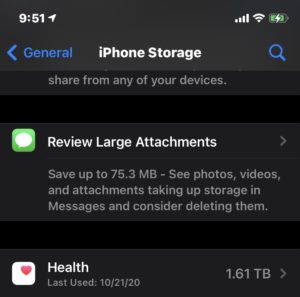When trying to upgrade to the iPhone 12 Pro, I got an error message saying that there wasn’t enough space on my new phone. That was the beginning of a couple of days of troubleshooting, culminating in a couple of hours on the phone with Apple Support to try to figure it out.

When I looked at my iPhone 11 Pro’s storage, the culprit was easy to spot: Apple Health says that it’s got 1.61TB of data. I have been working out a lot lately, but I don’t think that the data from my biking and my strength workouts is really that big.
That sent me to my Mac to see when my last backup was. I sync my phone with my Mac pretty frequently, so I thought that I’d be fine and could just use a recent backup. Not so: it turns out that my last backup to my phone was on September 16. September 16 coincides with another problem that I’ve been experiencing: ever since updating to iOS 14 on my iPhone 11, workout data from my Watch hasn’t been reliably syncing back to my phone. It seems to be okay with other workout apps, but not Apple’s Workout app. I’ve been using an app on my phone instead, which defeats the purpose of the Watch.
In doing my online research, I discovered others were having the same issue, but I couldn’t find any documentation of a solution. I called Apple Support. I have to give Apple credit: their tech support people are top-notch. The first agent did the basic troubleshooting with me, treated me well, and listened when I told her what I’d already done. She didn’t make me repeat steps that I’d already tried. When she was at the end of her expertise and had to escalate me, the second rep was just as great.
Here are the steps that we followed to get everything working again.
- Unpair my Apple Watch from my iPhone 11.
- Upgrade my iCloud storage to 2TB to accommodate the imaginary 1.61TB of data from Apple Health.
- Backup my iPhone 11 Pro to iCloud.
- Wait a couple of hours for my backup to upload. I had ~400GB of actual stuff on my iPhone, yours might go faster if you’ve got less data or faster wifi.
- On my new iPhone 12 Pro, have it restore from my iCloud backup. In Settings > iPhone Storage, I can see that my Watch has 75.2MB of data on it.
- Pair my Watch with my new iPhone.
- Restore the Watch from backup.
Per Support’s recommendation, I’m going to wait a week to make sure that everything is on my new iPhone as expected. Then I can delete that backup and downgrade my iCloud storage back to its normal tier.
Now I finally get to use my new iPhone 12 Pro! I got the Pacific Blue this time, which I like a lot more than the previous Midnight Green.